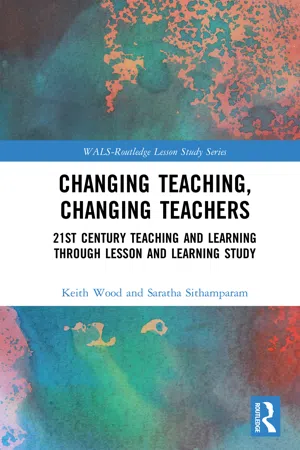
Changing Teaching, Changing Teachers
21st Century Teaching and Learning Through Lesson and Learning Study
- 138 pages
- English
- ePUB (mobile friendly)
- Available on iOS & Android
Changing Teaching, Changing Teachers
21st Century Teaching and Learning Through Lesson and Learning Study
About This Book
A unique feature of this book is its focus on engaging teachers themselves in changing teaching as a way to bring about teacher change through lesson study and learning study. The sequence – changing teaching, changing teachers – is significant. This approach to professional development is not about telling teachers what and how they should teach to bring about change in their students' learning outcomes. It is about empowering teachers to make their own decisions about what needs to change. Empowering teachers in this way has been identified as the 'soul' of Japanese lesson study (Cheng, 2019). It is the soul which can so easily be compromised when lesson study is adopted and – inevitably it seems – adapted in new contexts around the globe. Without teacher empowerment, top-down curriculum development is almost bound to fail. In presenting the cases of collaborative professional development included in this book, care has been taken to include the teachers' voices. They are intended to be the subjects and not the objects of our research into teachers' professional development.
Frequently asked questions
Information
1Changing teaching, changing teachers
Learning as changing as a person
Changing teaching
… they thought profit ruled absolutely. And I think also they thought that was the answer they should give in their economics lesson … I think that the way that they changed their minds so they came to see there were certain implications to thinking that – that meant you couldn’t interfere with things that we might think were morally unacceptable, you know, racism, etc… I think they came to see all these implications of that.
I think learning took place in seeing that there was more than one aspect to that and there were things that had to be weighed up and balanced against each other … I don’t know that there are really any economic truths there but I thought that was learning in an economics classroom … because it’s an economic issue – because they are talking about firms and the way they behave and that’s got clear implications for the allocation of resources …
… one of them is learning how to adapt to the knowledge that you have. In a sense, try and extract it through the students rather than giving it to them. It’s a subject based thing … working with economics in that respect. But on the other side is developing the social relationships between you and the students. Just how you should be pitching yourself in control terms.
I find interviewing students before and after lessons a little confusing because seeing through what they were saying and interpreting that as something that was intrinsically theirs and something that had been fed to them was confusing to me.
Focuses on the agent of teaching
… the hardest thing, just to walk into a classroom and take control … to get respect from students you’re working with when you’ve got to transmit information in a clear and logical way …… I think some of them learned from the lesson … They seemed to get down the information and were answering questions …
Focuses on the act of teaching
… They have to go through a process of trying to assimilate information and manipulate it in ways they think appropriate … the teacher has to facilitate that because most of the theories are fairly logical … you shouldn’t have to do too much to get them there …… Managing the learning process so that it goes in the direction you want without veering off in directions you don’t want …
Focuses on the object of learning
… looking at how the students responded was important but, before you can make sense of that data, you have to have an understanding of how you yourself learn and how you view the process of your own learning. Without that being made explicit to you, looking at other things is of limited value to you.… we found that it [the role play] served to reinforce their view about what business and property developers were all about – basically money … And then we had a problem getting them to challenge these views and giving them things to get them to consider wider aims such as environmental issues and responsibilities for workers’ safety … All issues we did raise with the role play but they tried to avoid … We thought raising the issue would be enough and it wasn’t … it’s what they make of it … we then have to look at what they are making of it, and look for something that will challenge what they’re doing with it rather than what we see that they should be doing with it … and there were opportunities ….
Table of contents
- Cover
- Half Title
- Series Page
- Title Page
- Copyright
- Table of Contents
- List of figures
- List of tables
- Preface
- Acknowledgements
- 1 Changing teaching, changing teachers
- 2 The many faces of lesson study
- 3 Learning study
- 4 Twenty-first-century teaching and learning design
- 5 Learning and variation
- 6 Critical aspects of the object of learning
- 7 Roles of teacher, researcher, facilitator, coach
- 8 Necessary conditions of teacher learning
- References
- Index